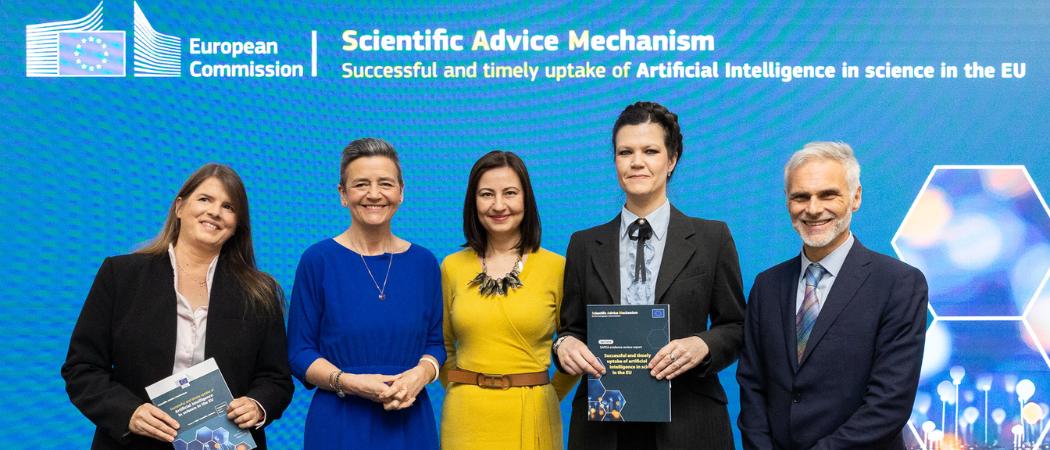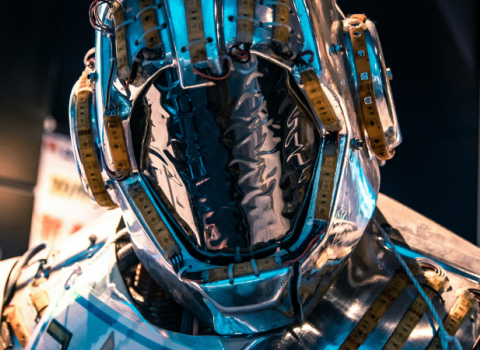Expert panel wants the European Commission to give academics more computing power and data to lead AI innovations. But critics say the proposal is too narrow, spread out across Europe, and lacks a concrete budget

Nicole Grobert (left), chair of the scientific advice group SAM, Margrethe Vestager (second from left), Commission executive vice-president, and research commissioner Iliana Ivanova (center) on April 15, 2024. Photo credits: Iliana Ivanova / Linkedin
Scientific advisors to the European Commission have recommended that the EU set up a “CERN for AI” to help scientists develop artificial intelligence tools to accelerate their research.
The Group of Chief Scientific Advisors, worried that AI research is dominated by private tech giants, wants the Commission to fund a “state-of-the-art facility for academic research in Europe”.
This facility, which they dub the European Distributed Institute for AI in Science (EDIRAS), takes forward the idea of a “CERN for AI”, modeled on the famous high-energy physics lab in Geneva. Setting up such a European research organisation is a longstanding demand by some in the AI community worried that the continent is falling further behind the US and China in the technology.
EDIRAS would give researchers “massive” high-performing computation power, a sustainable cloud infrastructure, high quality data, talent and training, says the advisory group, formally called the Scientific Advice Mechanism (SAM), in a report handed to the Commission today.
Probably the most famous example of AI in science is Alphafold, a system developed by Google-owned Deepmind, which can predict the structure of proteins, although there is some scepticism this will significantly speed up drug discovery.
With AI capabilities advancing at dizzying speed, the group’s recommendation was developed at an unusually fast pace, a sign of its political importance, said Nicole Grobert, a nanomaterials professor at the University of Oxford who chairs the scientific advice group.
“It usually takes a year, but here the request came in July and the pressure to finish was enormous. The Commission really wanted this report out,” she said.
But today’s proposal is much narrower than those campaigning for a “CERN for AI” would like to see.
Holger Hoos, an Alexander von Humboldt professor for AI at RWTH Aachen University and a founder of the Confederation of Laboratories for AI Research in Europe (Claire), said that while he was “thrilled” to see the idea gaining traction, it lacked the “ambition, vision and the kind of compelling motivation” set out in CERN for AI plans Claire has advanced over the last six years.
Too narrow?
The chief problem, in Hoos’s view, is that the proposed EDIRAS is focused largely on using AI to speed up science, rather than any broader uses that could benefit industry or government, say.
“We are all in favour of investing into AI for science, but we believe that this should not be the exclusive or even principal focus of ‘AI made in Europe’”, he said. “For example, ‘AI for engineering’, ‘AI for manufacturing’, ‘AI for public administration’ are all also very important,” he said.
Inside the Commission, there’s the view that creating AI tools for scientists could ultimately boost European innovation far more than the current wave of chatbots, such as ChatGPT, created by US tech giants.
“Using AI in science is probably one of the best use cases,” said competition commissioner Margrethe Vestager – who requested the review – today in a discussion of the report. “Me using AI to figure out how to make a dinner plan [...] may not be worth the energy used to do it.”
Rather than simply trying to ape the large language models of US tech giants, the EU could instead try to carve out AI niches where it can lead the world; and tools for AI science is one area in which the bloc has been relatively forward-thinking, a Commission official argued.
Too spread out?
The proposed EDIRAS institute would also be “distributed” - that is, spread out across the continent. “This has the advantage of bringing everyone on board. All parts of Europe would be included and have transparent and easy access,” said Grobert.
A physical institute in a single location would be outdated in the era of home working, she said.
One model could be Elixir, a federated data infrastructure set up by the European Molecular Biology Organisation, a Commission official said.
Kimmo Koski, CEO of CSC-IT Centre for Science in Finland and coordinator of the consortium which manages the LUMI supercomputer, said a distributed institute would make the most sense, and pointed out that most CERN scientists today are based around the world.
“It is much more feasible, cost-efficient and also quality-wise better to expand with the current concepts than to start from scratch,” he said.
Supercomputers like LUMI within the EU’s EuroHPC joint undertaking are already well designed to support the development of AI systems. “I think the win-win situation in Europe and EuroHPC is when we are able to provide different kinds of resources for different kinds of needs, with the same ecosystem,” Koski said.
But Hoos wants a new central facility with supercomputers used exclusively for AI. “I believe any moonshot effort needs a visible focal point,” he said. He’s also worried that the distributed nature of EDIRAS could “far too easily be implemented by relatively cost-neutral rebranding of rather ineffective existing initiatives”.
Grobert acknowledged that EDIRAS would encompass existing AI facilities, but would also involve “investing heavily in new infrastructure” as well.
A Commission source pointed out that it would be difficult to get EU states to agree to a centralised location for a new CERN-like facility, given the sensitivity of AI.
Hoos also said that neither he nor a “major part of the AI community” had been consulted on the report, despite championing the CERN for AI idea it takes up. “That doesn’t bode well in terms of making sure that those who would benefit from or shape it if implemented are on board,” he said.
The SAM report was based partly on an evidence review by a consortium of Europe’s leading science academies, called Science Advice for Policy by European Academies. A policy advisor for that group said they had consulted a member of Claire’s extended core team when gathering the evidence.
Budget
Then there’s the question of the budget. Today’s report does not specify a cost for EDIRAS, which Grobert said was a decision for the Commission. It “needs to take a bold approach” in order to be competitive, she said. Claire and non-profit association euRobotics, meanwhile, have asked for €100 billion over six years.
But according to a Commission source, the most plausible path was to pilot EDIRAS as part of Horizon Europe, with the potential to scale it up from 2028 in the next framework programme – a similar path taken by the European Innovation Council, which was trialed in the later stages of Horizon 2020.
This would admittedly mean a delay until 2028 to get it fully off the ground, but there were no other obvious EU funding mechanisms to hand, they said.
Mattias Björnmalm, secretary general of CESAER, an association of European universities of science and technology, welcomed the science-focused approach to AI, and the effort to tackle these issues at a European level.
“Part of the reasoning for CERN from a scientific perspective was the pooling of resources to make and advance huge infrastructure, which is difficult to do on an individual level,” he said.
But he would have liked to have seen more clarity on the required budget. There is too often a disconnect between political ambitions, and decisions to cut programmes such as Horizon Europe which are key to their implementation.
The SAM report also recommends “creative” public-private partnerships to make private data available for research with AI, and to provide financial support for the development of specialised tools for scientists, such as foundation models and AI research assistants.
The efforts should focus not only on physical and life sciences, but also on humanities and social sciences, and they should ensure that AI systems are aligned with “European values”, the scientific advisors say.
It is now up to the Commission to decide to what extent it will implement the recommendations. It comes after the Commission published its own set of guidelines for the use of generative AI in research.





 A unique international forum for public research organisations and companies to connect their external engagement with strategic interests around their R&D system.
A unique international forum for public research organisations and companies to connect their external engagement with strategic interests around their R&D system.